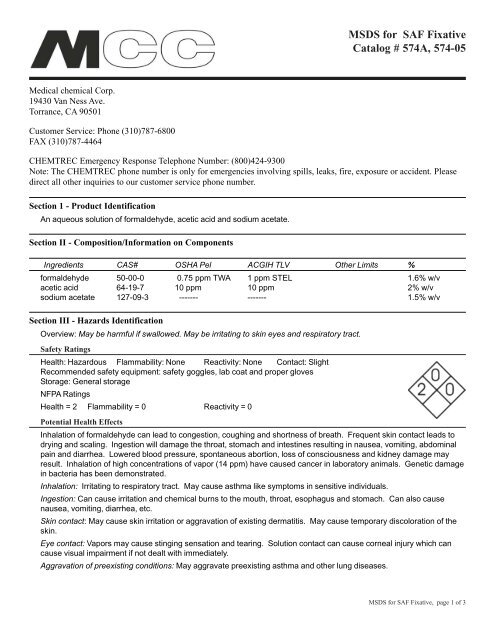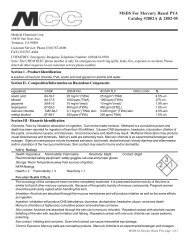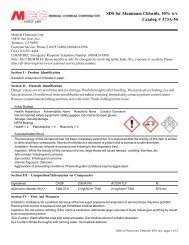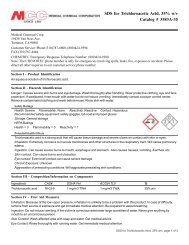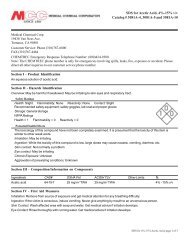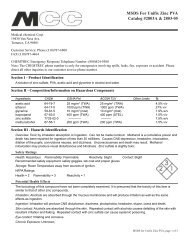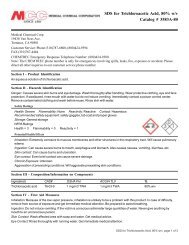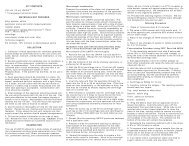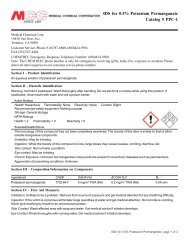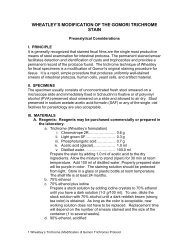MSDS for SAF Fixative Catalog # 574A 574-05
MSDS - Medical Chemical Corporation
MSDS - Medical Chemical Corporation
Create successful ePaper yourself
Turn your PDF publications into a flip-book with our unique Google optimized e-Paper software.
<strong>MSDS</strong> <strong>for</strong> <strong>SAF</strong> <strong>Fixative</strong><br />
<strong>Catalog</strong> # <strong><strong>574</strong>A</strong>, <strong>574</strong>-<strong>05</strong><br />
Medical chemical Corp.<br />
19430 Van Ness Ave.<br />
Torrance, CA 9<strong>05</strong>01<br />
Customer Service: Phone (310)787-6800<br />
FAX (310)787-4464<br />
CHEMTREC Emergency Response Telephone Number: (800)424-9300<br />
Note: The CHEMTREC phone number is only <strong>for</strong> emergencies involving spills, leaks, fire, exposure or accident. Please<br />
direct all other inquiries to our customer service phone number.<br />
Section 1 - Product Identification<br />
An aqueous solution of <strong>for</strong>maldehyde, acetic acid and sodium acetate.<br />
Section II - Composition/In<strong>for</strong>mation on Components<br />
Ingredients CAS# OSHA Pel ACGIH TLV Other Limits %<br />
<strong>for</strong>maldehyde 50-00-0 0.75 ppm TWA 1 ppm STEL 1.6% w/v<br />
acetic acid 64-19-7 10 ppm 10 ppm 2% w/v<br />
sodium acetate 127-09-3 ------- ------- 1.5% w/v<br />
Section III - Hazards Identification<br />
Overview: May be harmful if swallowed. May be irritating to skin eyes and respiratory tract.<br />
Safety Ratings<br />
Health: Hazardous Flammability: None Reactivity: None Contact: Slight<br />
Recommended safety equipment: safety goggles, lab coat and proper gloves<br />
Storage: General storage<br />
NFPA Ratings<br />
Health = 2 Flammability = 0 Reactivity = 0<br />
Potential Health Effects<br />
Inhalation of <strong>for</strong>maldehyde can lead to congestion, coughing and shortness of breath. Frequent skin contact leads to<br />
drying and scaling. Ingestion will damage the throat, stomach and intestines resulting in nausea, vomiting, abdominal<br />
pain and diarrhea. Lowered blood pressure, spontaneous abortion, loss of consciousness and kidney damage may<br />
result. Inhalation of high concentrations of vapor (14 ppm) have caused cancer in laboratory animals. Genetic damage<br />
in bacteria has been demonstrated.<br />
Inhalation: Irritating to respiratory tract. May cause asthma like symptoms in sensitive individuals.<br />
Ingestion: Can cause irritation and chemical burns to the mouth, throat, esophagus and stomach. Can also cause<br />
nausea, vomiting, diarrhea, etc.<br />
Skin contact: May cause skin irritation or aggravation of existing dermatitis. May cause temporary discoloration of the<br />
skin.<br />
Eye contact: Vapors may cause stinging sensation and tearing. Solution contact can cause corneal injury which can<br />
cause visual impairment if not dealt with immediately.<br />
Aggravation of preexisting conditions: May aggravate preexisting asthma and other lung diseases.<br />
<strong>MSDS</strong> <strong>for</strong> <strong>SAF</strong> <strong>Fixative</strong>, page 1 of 3
Section IV - First Aid Measures<br />
Inhalation: Remove from source of exposure and get medical attention <strong>for</strong> any breathing difficulty.<br />
Ingestion: Drink large quantities of fluids and call a physician immediately. Administer activated charcoal or other<br />
adsorbent if available.<br />
Skin Contact: Wash affected area with soap and water. Get medical advice if irritation develops.<br />
Eye Contact: Immediately flush thoroughly with running water <strong>for</strong> at least 15 minutes. Get immediate medical advice.<br />
Section V - Fire Fighting Measures<br />
Flash point: Not applicable.<br />
Flammable Limits: Not applicable.<br />
Fire: Not normally a fire Hazard,<br />
Explosion: Not Normally an explosion hazards.<br />
Fire Extinguishing Media: Any means suitable <strong>for</strong> surrounding fire.<br />
Special in<strong>for</strong>mation: Pyrolysis will release corrosive oxides.<br />
Section VI - Accidental Release Measures<br />
Wear appropriate protective gear such as gloves, apron and protective eye wear. Absorb with a suitable absorbent<br />
(such as paper towels) and store in a suitable container <strong>for</strong> disposal. Large spills may be neutralized with <strong>for</strong>malin<br />
neutralizers.<br />
Section VII - Handling and Storage<br />
Store in a closed container at controlled room temperature, 59 o F to 86 o F (15 o C to 30 o C).<br />
Section VIII - Exposure Control/Personal Protection<br />
Airborne Exposure Limits: See section II<br />
Ventilation System: Use appropriate ventilation. Laboratory fume hoods or similar apparatus are recommended <strong>for</strong><br />
handling <strong>for</strong>maldehyde solutions. When required, Refer to the ACGIH document, “Industrial Ventilation, a Manual of<br />
Recommended Practices” <strong>for</strong> details about ventilation.<br />
Personal Respirator: Required if threshold limit value <strong>for</strong> <strong>for</strong>maldehyde is exceeded. In case of emergency, or when<br />
exposure levels are unknown, use a half face or full face respirator with organic vapor cartridges.<br />
Skin protection: Chemical resistant gloves are recommended.<br />
Eye Protection: Laboratory safety goggles, safety glasses or face shield are required.<br />
People who regularly work with <strong>for</strong>maldehyde are required to have regular medical surveillance.<br />
Section IX - Physical and Chemical Properties<br />
Boiling Point: 98-100 o C<br />
Density: About 1.01 g/ml<br />
Vapor pressure (mm Hg): 18 @ 20 o C Evaporation Rate (water = 1): 1<br />
Vapor Density (air = 1): 0.6<br />
Solubility: Infinitely miscible with water<br />
Appearance and Odor: A clear liquid with the odors of vinegar and <strong>for</strong>maldehyde.<br />
Section X - Stability and Reactivity<br />
Stability: Freezes at low temperature.<br />
Hazardous Decomposition Products: Nothing unusual.<br />
Hazardous polymerization: Will not occur.<br />
Incompatibilities: Nothing unusual.<br />
Conditions to avoid: Excessive cold/heat and light.<br />
<strong>MSDS</strong> <strong>for</strong> <strong>SAF</strong> <strong>Fixative</strong>, page 2 of 3
Section XI - Toxicological In<strong>for</strong>mation<br />
Toxicity: The chronic toxicity of this product is unknown but may include sensitization in sensitive individuals. The manufacturer is<br />
unaware of any target organ toxicity. Formaldehyde is a known human carcinogen<br />
Cancer lists<br />
Ingredient Known Carcinogenicity? NTP? Anticipated? IARC Category<br />
<strong>for</strong>maldehyde yes no yes 2A<br />
acetic acid no no no none<br />
sodium acetate no no no none<br />
Section XII - Ecological In<strong>for</strong>mation<br />
Environmental Fate: Biodegradable<br />
Environmental Toxicity: Formaldehyde is expected to be slightly toxic to fish.<br />
Section XIII - Disposal<br />
Incineration is the preferred disposal method <strong>for</strong> <strong>for</strong>maldehyde. Local governments often restrict the amounts of<br />
aldehydes that may be flushed down drain. Insure compliance with all government regulation<br />
Section XIV - Transportation in<strong>for</strong>mation<br />
Not Regulated<br />
Section XV - Regulatory In<strong>for</strong>mation<br />
Chemical Inventory Status<br />
Ingredient TSCA EC<br />
<strong>for</strong>maldehyde Yes Yes<br />
acetic acid Yes Yes<br />
sodium acetate Yes Yes<br />
Federal, State and International Regulations<br />
SARA 302 SARA 313 RCRA TSCA<br />
Ingredient RQ TPQ List Category 261.33 8(D)<br />
<strong>for</strong>maldehyde 100 500 Yes No U122 No<br />
acetic acid No No No No No No<br />
sodium No No No No No No<br />
Ingredient Chemical Weapons Convention TSCA 12(b) CDTA<br />
<strong>for</strong>maldehyde No No No<br />
acetic acid No No No<br />
sodium acetate No No No<br />
SARA 311/312<br />
Ingredient Acute? Chronic?<br />
<strong>for</strong>maldehyde Yes Yes<br />
acetic acid Yes No<br />
sodium acetate No No<br />
Section XVI - Other In<strong>for</strong>mation<br />
This in<strong>for</strong>mation is believed to be correct but is not waranteed as such, nor does it purport to be all inclusive.<br />
Prepared by: P. B. Revision Date: Dec. 12, 20<strong>05</strong><br />
<strong>MSDS</strong> <strong>for</strong> <strong>SAF</strong> <strong>Fixative</strong>, page 3 of 3


